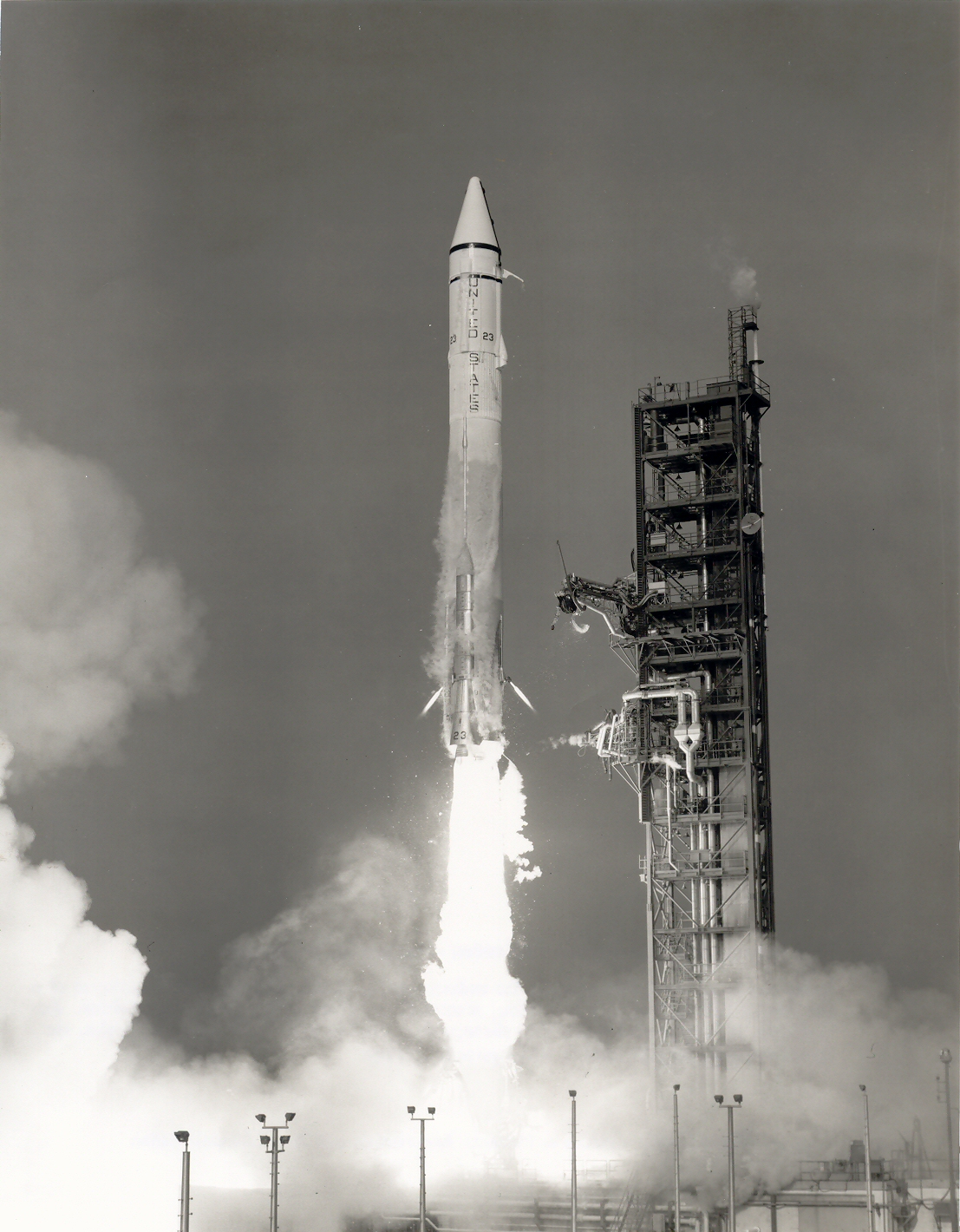
Atlas SLV-3C Centaur
In-activeConvair ()
Sept. 8, 1967
Description
The Atlas-Centaur was a US expendable launch vehicle derived from the SM-65 Atlas D missile. Launches were conducted from Launch Complex 36 at the Cape Canaveral Air Force Station in Florida.
Specifications
-
Stages
2 -
Length
21.0 m -
Diameter
3.05 m -
Fairing Diameter
3.05 m -
Launch Mass
120.0 T -
Thrust
―
Family
-
Name
Atlas SLV-3C Centaur -
Family
― -
Variant
SLV-3C Centaur -
Alias
― -
Full Name
Atlas SLV-3C Centaur
Payload Capacity
-
Launch Cost
― -
Low Earth Orbit
800.0 kg -
Geostationary Transfer
Orbit
― -
Direct Geostationary
― -
Sun-Synchronous Capacity
―
Convair
Commercial
None
1943Convair, previously Consolidated Vultee, was an American aircraft manufacturing company that later expanded into rockets and spacecraft. The company was formed in 1943 by the merger of Consolidated Aircraft and Vultee Aircraft. In 1953 it was purchased by General Dynamics, and operated as their Convair Division for most of its corporate history.
Atlas SLV-3C Centaur | Copernicus
Convair | United States of AmericaCape Canaveral SFS, FL, USA
Aug. 21, 1972, 10:28 a.m.
Atlas SLV-3C Centaur | INTELSAT IV F5
Convair | United States of AmericaCape Canaveral SFS, FL, USA
June 13, 1972, 9:53 p.m.
Atlas SLV-3C Centaur | Pioneer 10
Convair | United States of AmericaCape Canaveral SFS, FL, USA
March 3, 1972, 1:49 a.m.
Atlas SLV-3C Centaur | INTELSAT IV F4
Convair | United States of AmericaCape Canaveral SFS, FL, USA
Jan. 23, 1972, 12:12 a.m.
Atlas SLV-3C Centaur | INTELSAT IV F3
Convair | United States of AmericaCape Canaveral SFS, FL, USA
Dec. 20, 1971, 1:10 a.m.
Atlas SLV-3C Centaur | Mariner 9
Convair | United States of AmericaCape Canaveral SFS, FL, USA
May 30, 1971, 10:23 p.m.
Atlas SLV-3C Centaur | Mariner 8
Convair | United States of AmericaCape Canaveral SFS, FL, USA
May 9, 1971, 1:11 a.m.
Atlas SLV-3C Centaur | INTELSAT IV F2
Convair | United States of AmericaCape Canaveral SFS, FL, USA
Jan. 26, 1971, 12:36 a.m.
Atlas SLV-3C Centaur | OAO B
Convair | United States of AmericaCape Canaveral SFS, FL, USA
Nov. 30, 1970, 10:40 p.m.
Atlas SLV-3C Centaur | ATS 5
Convair | United States of AmericaCape Canaveral SFS, FL, USA
Aug. 12, 1969, 11:01 a.m.
Status: Launch Successful
Mission:
ATS-5, the last spacecraft in the Hughes/NASA ATS program, was launched August 12, 1969, in a near-perfect trajectory for insertion into synchronous orbit. Although injected successfully into orbit, the spacecraft's reverse spin (counterclockwise) prevented successful deployment of the 124 foot gravity gradient booms for the stabilization experiment. However nine of the other 13 experiments aboard the spacecraft returned useful data.
Geosynchronous OrbitAtlas SLV-3C Centaur | Mariner 7
Convair | United States of AmericaCape Canaveral SFS, FL, USA
March 27, 1969, 10:22 p.m.
Status: Launch Successful
Mission:
Mariner 6 and 7 comprised a dual-spacecraft mission to Mars, the sixth and seventh missions in the Mariner series of spacecraft used for planetary exploration in the flyby mode. The primary objectives of the missions were to study the surface and atmosphere of Mars during close flybys to establish the basis for future investigations, particularly those relevant to the search for extraterrestrial life, and to demonstrate and develop technologies required for future Mars missions and other long-duration missions far from the Sun.
Mars flybyAtlas SLV-3C Centaur | Mariner 6
Convair | United States of AmericaCape Canaveral SFS, FL, USA
Feb. 25, 1969, 1:29 a.m.
Status: Launch Successful
Mission:
Mariner 6 and 7 comprised a dual-spacecraft mission to Mars, the sixth and seventh missions in the Mariner series of spacecraft used for planetary exploration in the flyby mode. The primary objectives of the missions were to study the surface and atmosphere of Mars during close flybys to establish the basis for future investigations, particularly those relevant to the search for extraterrestrial life, and to demonstrate and develop technologies required for future Mars missions and other long-duration missions far from the Sun.
Mars flybyAtlas SLV-3C Centaur | OAO 2
Convair | United States of AmericaCape Canaveral SFS, FL, USA
Dec. 7, 1968, 8:40 a.m.
Atlas SLV-3C Centaur | ATS 4
Convair | United States of AmericaCape Canaveral SFS, FL, USA
Aug. 10, 1968, 10:33 p.m.
Atlas SLV-3C Centaur | Surveyor 7
Convair | United States of AmericaCape Canaveral SFS, FL, USA
Jan. 7, 1968, 6:30 a.m.
Atlas SLV-3C Centaur | Surveyor 6
Convair | United States of AmericaCape Canaveral SFS, FL, USA
Nov. 7, 1967, 7:39 a.m.
Falcon 9
Starlink Group 10-51
Launch Complex 39A - Kennedy Space Center, FL, USAA batch of 29 satellites for the Starlink mega-constellation - SpaceX's project for space-based Internet communication system.
Kinetica 1
Chutian-2 01 & 02
Launch Area 130 - Jiuquan Satellite Launch Center, People's Republic of China2 satellites built by the China Aerospace Science and Industry Corporation (CASIC) for testing operations of Very Low Earth Orbit (VLEO) satellites f…
Long March 11
Shiyan 32 01-03
Oriental Spaceport mobile launch ship - Sea Launch3 Chinese satellites reported to be for "orbital technological testing" purposes. Actual usage not known.
Falcon 9
Starlink Group 11-14
Space Launch Complex 4E - Vandenberg SFB, CA, USAA batch of 28 satellites for the Starlink mega-constellation - SpaceX's project for space-based Internet communication system.
Falcon 9
Starlink Group 6-81
Space Launch Complex 40 - Cape Canaveral SFS, FL, USAA batch of 29 satellites for the Starlink mega-constellation - SpaceX's project for space-based Internet communication system.

